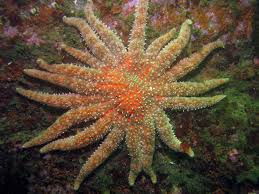Sunflower Star Fish:

Scientists have found the culprit of a mysterious disease which started killing off sunflower starfish in droves — more than 5 billion are estimated to have died since 2013 is a bacterium called Vibrio pectenicida.
- The Sunflower Sea Star (Pycnopodia helianthoides) is among the largest and fastest sea stars in the world.
- It is commonly found on various substrates like mud, sand, gravel, boulders and rock. They are found from the intertidal coastal waters zone to 435 m, however, most are found no more than 120 m.
- It lives along the vast majority of the Pacific coast of North America.
- It has a radially symmetrical body and has more arms than any other species, numbering between 15 and 24 (most sea stars have between 5 and 14).
- There is no sexual dimorphism within these species. Fertilization is external.They breed by broadcast fertilization between March and July
- They have the ability to regenerate its arms which may detach as a means of defense when handled excessively or attacked by a predator.
- A whole new sea star may form if the detached arm has a portion of the central disk included.
- These species are primarily carnivorous, feeding on mussels, sea urchins, fish, crustaceans etc.
- These are opportunistic hunters of a wide range of marine invertebrates, and in some areas are important predators that regulate surrounding ecosystems.
- As a predator of sea urchins, which graze kelp, the species helps keep kelp forests healthy.




